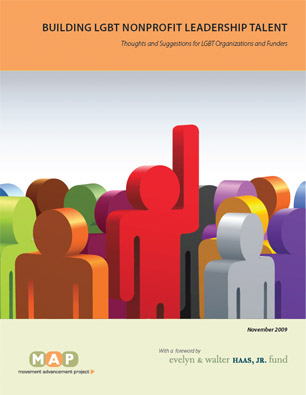The Bottom Line
Based on 18 months of research, Building LGBT Nonprofit Leadership Talent examines why intentional and consistent action to support, nurture and strengthen leadership talent should become an ingrained part of how lesbian, gay, bisexual and transgender (LGBT) movement organizations conduct their day-to-day work. The report also offers practical recommendations for prioritizing the development of LGBT leadership.
- Building LGBT Nonprofit Leadership Talent Download
Abstract
The LGBT movement has made tremendous strides in advancing legal and social equality in recent years. Yet at the same time, the movement has entered a period of leadership transition as longtime leaders begin to pass the torch to a new generation. Adding to the leadership challenge, both veteran and emerging leaders are facing new demands and heightened expectations in quickly shifting political and cultural climates. Organizations and funders agree that the time is right for increased investments in leadership for LGBT nonprofits, yet current investments in leadership are not keeping pace with the needs of the movement.
In order to build on recent victories and accelerate progress, MAP believes the movement must make a more intentional investment in supporting and strengthening its leaders. In Building LGBT Nonprofit Leadership Talent, MAP argues that supporting and strengthening leadership talent should be an explicit, long-term priority of the movement for LGBT equality, and provides both a vision and pragmatic recommendations for action.
The report proposes a five-part model for building nonprofit leadership, noting that the fundamental challenge facing the movement goes beyond the need to develop people; rather, it is about ensuring that organizations have the leadership talent they need. The MAP model for building nonprofit leadership involves:
- Defining strategic aims
- Recruiting great people
- Deploying and managing people well
- Developing people on the job and offsite
- Retaining the best people
The recommendations that flow from this model include several joint initiatives that LGBT organizations can pursue together to strengthen talent building across the movement.
The report also includes a series of appendices, including a list of leadership development programs currently serving LGBT nonprofits, a leadership snapshot assessment tool, a list of recommended open-enrollment leadership development programs, and more.


